

Race predictor. Four Key Core Exercises For Runners - Page 5 of 5.
Icicle: Running the Mont Blanc Marathon (Marathon du Mont Blanc) in Chamonix. About IcicleUK.com.
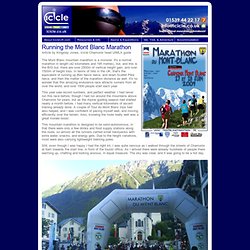
Running On Air: Breathing Technique. This article was adapted from Running on Air: The Revolutionary Way to Run Better by Breathing Smarter, by Budd Coates, M.S., and Claire Kowalchik (Rodale, 2013).
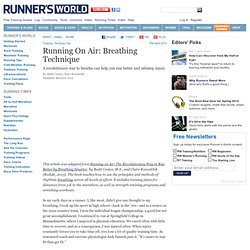
The book teaches how to use the principles and methods of rhythmic breathing across all levels of effort. It includes training plans for distances from 5-K to the marathon, as well as strength-training programs and stretching workouts. In my early days as a runner, I, like most, didn't give any thought to my breathing. I took up the sport in high school—back in the '70s—and as a senior on the cross-country team, I won the individual league championship, a good but not great accomplishment. I continued to run at Springfield College in Massachusetts, where I majored in physical education. I spent lots of time in the college's physiology building (there were no cross-training facilities) on a Monarch test bike, pedaling away to maintain my conditioning.
Hmm. In Hinduism, yoga teaches pranayama—breath work. 1. Long-distance running and evolution: Why humans can outrun horses but can’t jump higher than cats. By Chris McGrath/Getty Images.

At first glance the annual Man vs. Horse Marathon, set for June 9 in Wales, seems like a joke sport brought to us by the same brilliant minds behind dwarf tossing and gravy wrestling. It was, after all, the product of a pints-fueled debate in a Welsh pub, and for years its official starter was rock musician Screaming Lord Sutch, founder of the Official Monster Raving Loony Party.
But the jokiness is misleading: When viewed through science’s clarifying lens, the funny marathon is one of the few sports that isn’t a joke. Make A High Stride Rate Work For You. Over and over, top runners maintain consistently high stride rates — and so should you.

Running speed is a function of two very simple things: the length of your running stride and the frequency at which you take those strides. To go faster, either one or the other has to increase. But, for elite runners, one of those two rarely changes. Top-level distance runners typically run at a high number of steps per minute – between 180-200 – no matter what speed they’re going; simply varying the length of their stride to run faster or slower.
“Fitter people have a little longer stride, but the rate stays the same,” said Jack Daniels, coach, exercise physiologist and author of the seminal book Daniels’ Running Formula, which first included analysis of stride rate. Daniels’ initial study that established the magic number of 180 steps per minute was conducted during the 1984 Olympics. Run Softly, Naturally. For years, running coaches and elite athletes have preached that good running form is the key to efficient running and faster times.
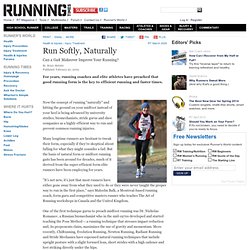
Now the concept of running "naturally" and hitting the ground on your midfoot instead of your heel is being advanced by university studies, biomechanists, stride gurus and shoe companies as a highly efficient way to run and prevent common running injuries. Many longtime runners are hesitant to tweak their form, especially if they're skeptical about falling for what they might consider a fad. But the basis of natural form or midfoot running gaits has been around for decades, much of it derived from the super-efficient form elite runners have been employing for years. One of the first technique gurus to preach midfoot running was Dr. Why Runners Don't Get Knee Arthritis. 8 Biggest Myths about Starting to Run, Debunked by Olympians & U.S Champs. Janji recently asked several of the best distance runners in the world to hear what they thought were the biggest misconceptions about running for beginners.

Below is their advice: Myth #8: It’s not ok to walk- Shannon Rowbury, @ShannonRowbury 2 x Olympian in 1500 (2008, 2012); 1500 World Bronze Medalist (2009) Shannon wrote to us that beginner runners too often think “That it’s not ok to walk a little bit when they’re tired.” Common Misconceptions About Running.
Running is a funny sport.

It almost feels odd to call it a sport because it is so simple. You just put one foot in front of the other. Many, many times. Researchers explode the myth about running injuries. Public release date: 14-Jun-2013 [ Print | E-mail Share ] [ Close Window ] Contact: Rasmus Oe.
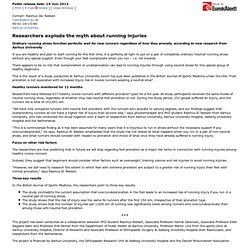
Nielsenroen@sport.au.dk 45-61-18-15-99Aarhus University If you are healthy and plan to start running for the first time, it is perfectly all right to put on a pair of completely ordinary 'neutral' running shoes without any special support. Even though your feet overpronate when you run – i.e. roll inwards. 5 Myths About Distance Running.
Editor’s Note: This is a guest post from Jason Fitzgerald, a USA Track & Field certified coach.

Hey Skinny, looks like it’s time for some push-ups! So, you live on pasta and bagels right? Running isn’t a real sport! After more than 14 years of running experience – in high school, college, and ever since – I’ve heard every insult and misconception that exists about the sport of distance running. Some are true (yes, our shorts are short), but most are false. Running has a bad reputation that seems to be exaggerated by some fitness circles that don’t understand the right way to train for road races like the 5k, 10k, or even the marathon. Flash back about 40 years and you’ll see that runners ran a lot of miles at a slower pace – and did little else in the general fitness and strength departments. If we look even further back in history – back to the 1950s when Roger Bannister became the first man in history to run a sub-4:00 mile – training looked wildly different. Common Misconceptions About Running.
Running. Running Tips: The Truth Behind 8 Common Running Myths-Shape Magazine. You've probably heard several of them numerous times—"be sure to stretch before you run" and "always finish your runs with a cool down"—but is there any real truth to them?
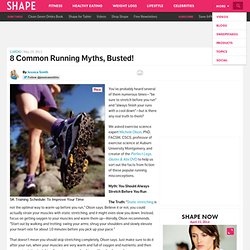
We asked exercise science expert Michele Olson, PhD, FACSM, CSCS, professor of exercise science at Auburn University Montgomery, and creator of the Perfect Legs, Glutes & Abs DVD to help us sort out the facts from fiction of these popular running misconceptions. Myth: You Should Always Stretch Before You Run The Truth: "Static stretching is not the optimal way to warm-up before you run," Olson says. Believe it or not, you could actually strain your muscles with static stretching, and it might even slow you down. Instead, focus on getting oxygen to your muscles and warm them up—literally, Olson recommends. That doesn’t mean you should skip stretching completely, Olson says. McMillan Running - Calculator.